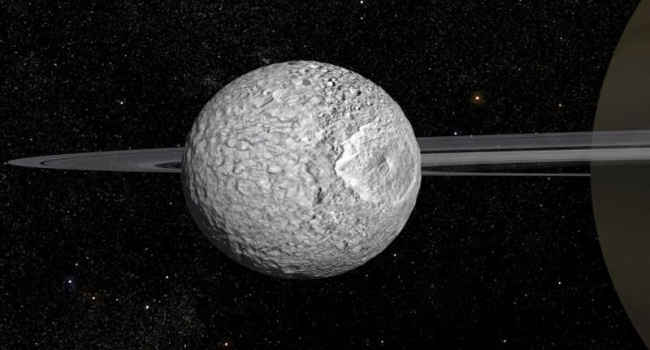
New discovery: There may be huge ocean in the crust of Saturn's moon Mimas
In comparison to other large moons of Saturn (and Jupiter), the moon Mimas is not rich in cracks and fissures, resembling our Moon with its craters. Therefore, it might seem to be a dry world of rocky materials; however, the reality appears to be different. Mimas has a peculiar orbit, as if something inside it is sloshing around, or its core has an unusually elongated shape. Modeling suggests the presence of a hidden ocean, marking a significant discovery for scientists.
Detailed data on the Saturn system was collected by the Cassini spacecraft during the period from 2004 to 2017. A group of scientists from the Paris Observatory utilized this information to reevaluate the orbital parameters of Mimas, which, due to its enormous impact crater, resembles the "Death Star." They aimed to eliminate one of the scenarios that makes the orbit of this moon appear unusual for a monolithic rocky celestial body.
According to one scenario, Mimas may have a highly elongated core causing oscillatory movements along its orbit. In another case, beneath its rocky surface, there could be a global watery world, the flows of which also induce changes in the satellite's orbital motion.

Modeling showed that the existence of an elongated core is the least likely scenario. Considering the dynamics of Mimas's orbital motion under the influence of Saturn's gravity and its other major moons, the orbital parameters of this mysterious moon are more likely explained by the presence of a liquid subsurface ocean.
Calculations indicate that this liquid ocean on Mimas is relatively young, only 2–3 million years old. Most likely, shortly before its formation, the orbit of this moon changed from stable circular to elongated, which is considered normal in systems with multiple moons. Saturn's gravity began intermittently affecting the depths of Mimas, leading to gravitational heating of its core and internal structure. As a result, water began to emerge in liquid form, gradually forming a global subsurface ocean, which has now risen close to the surface of Mimas by 20–30 kilometers.
From the external appearance of this moon, one cannot tell that beneath its crust lies a mass of water much greater than Earth's oceans. Mimas lacks the cracks and geysers seen on the moons Enceladus, Europa, Ganymede, and Titan, which kept its secret hidden for a long time. Equally important is that if there is indeed a global ocean, its youth provides an opportunity to glimpse into the past of other moons of Saturn and Jupiter, aiding in understanding the evolutionary development of subsurface watery worlds.
- Related News
- Perseverance finds rock on Mars with signs of life on Earth (photo)
- On 25th anniversary of Chandra telescope, NASA released 25 photos previously unseen by the public
- Rare intermediate-mass black hole has been discovered at the center of our galaxy
- Stone "snowman" and pure sulfur crystals on Mars։ Remarkable discoveries by Perseverance and Curiosity
- When will humanity settle on Mars? Interview with Gernot Grömer
- TESS telescope discovers super-hot exoplanet the size of Neptune
- Most read
month
week
day
- With today's mortgage interest rates, banks simply cannot sell products in 2025: Interview with Vardan Marutyan 817
- Ants and bees 'taught' tiny drones to navigate without GPS, beacons or lidars 677
- Samsung will release Galaxy Tab S10+ and Ultra tablets and Galaxy Z Fold 6 Slim and Galaxy w25 smartphones in October 645
- Mass production of iPhone SE 4 will begin this October, with sales starting in 2025 609
- Insider unveils specs of all smartphones of iPhone 17 series, including the 17 Slim 607
- Telegram's monthly active audience reaches 950 million 587
- What are the problems in the construction industry? Interview with Vardan Marutyan 571
- For the first time in history, iPhone will get a Samsung camera 568
- Three best Xiaomi budget smartphones recommended to buy 560
- What dangers can feature phones from unknown manufacturers conceal? 560
- Archive
